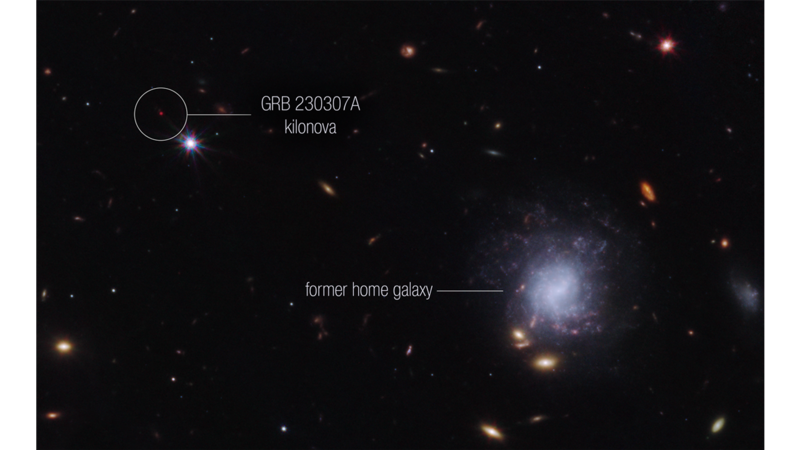English: Webb Space Telescope
Main Navigation
Home
News
Images
Videos
Science
Resource Gallery
Recursos en español
Quick Facts
Glossary
About Us
Contact Us
Other Webb Sites
Kilonova and Host Galaxy
READ NEWS RELEASE VIEW ALL IMAGES
Bright galaxies and other light sources in various sizes and shapes are scattered across a black swath of space: small points, hazy elliptical-like smudges with halos, and spiral-shaped blobs. The objects vary in color: white, blue-white, yellow-white, and orange-red. Toward the center right is a blue-white spiral galaxy seen face-on that is larger than the other light sources in the image. The galaxy is labeled “former home galaxy.” Toward the upper left is a small red point, which has a white circle around it and is labeled “GRB 230307A kilonova.”
Zoom Image
PaginationPrevious2 of 3Next
About This Image
Release Date
October 25, 2023 11:00AM (EDT)
Read the Release
Release ID: 2023-134
Permissions
Content Use Policy
Download Options
Full Res Main, 2525 X 1561, TIF (4.90 MB)
Full Res Main, 2525 X 1561, PNG (4.05 MB)
Crop Main, 2000 X 1236, PNG (2.57 MB)
Full Res Wide, 4316 X 2826, TIF (15.31 MB)
Full Res Wide, 4316 X 2826, PNG (12.50 MB)
Wide, 2000 X 1310, PNG (3.01 MB)
Caption
A team of scientists has used NASA’s James Webb Space Telescope to observe an exceptionally bright gamma-ray burst, GRB 230307A, and its associated kilonova. Kilonovas—an explosion produced by a neutron star merging with either a black hole or with another neutron star—are extremely rare, making it difficult to observe these events. The highly sensitive infrared capabilities of Webb helped scientists identify the home address of the two neutron stars that created the kilonova.
This image from Webb’s NIRCam (Near-Infrared Camera) instrument highlights GRB 230307A’s kilonova and its former home galaxy among their local environment of other galaxies and foreground stars. The neutron stars were kicked out of their home galaxy and traveled the distance of about 120,000 light-years, approximately the diameter of the Milky Way galaxy, before finally merging several hundred million years later.




